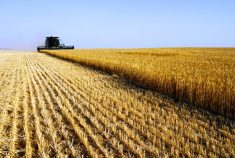Enough moisture, a bit too much moisture and way too much moisture — that was the picture that has emerged in recent days across the three Prairie provinces.
Alberta Agriculture and Rural Development is continuing to assess how crop and livestock producers have been affected by dramatic flooding in the southeast part of that province.
Recent media reports cite Agriculture Minister Verlyn Olson saying it’s only after the water recedes that the full extent of the impact will be known.
Initial reports suggest most of the damage is isolated to areas along river banks and creeks, Olson recently told the Bloomberg news service. Officials are also monitoring the integrity of dams used for farm irrigation, Olson said.
Read Also

Brazil to reap record soy crop in 2025/2026, increase exports
Brazil’s Conab said the country will reap a record soybean crop of 177.6 million tons in the 2025/2026 harvest year, according to data released on Thursday.
Communities in southern Alberta experienced heavy rainfall beginning on June 19 and some 75,000 residents of Calgary, the province’s largest city, were evacuated. Three deaths have been reported outside of the metropolitan area.
Just prior to the start of the flooding event, the province released its regular crop report, which showed more than 85 per cent of the province’s crops were rating good to excellent, and good moisture levels were reported throughout much of the growing season.
In Saskatchewan, growers have been largely spared any major weather events so far, and seeding has essentially wrapped up with an estimated 98 per cent of the 2013 crop in the ground, putting the crop on pace with the five-year average.
Crops are off to a good start this year, despite a late start, the Saskatchewan ag ministry’s crop report said. Soil moisture ratings are very good — though sometimes too good, with five per cent of the province rated excessive. 87 per cent of the province is rated good/excellent for surface soil moisture, while 84 per cent is rated good/excellent for subsoil moisture.
Warmer temperatures are needed to enhance crop development which has been slowed by the cool spring and to allow spraying to be completed. Currently, spraying is estimated to be 47 per cent completed.
Many areas of Manitoba received significant amounts of rainfall over the past several days. Impact to crops is being assessed and will depend on the stage of crop development and duration of the excessive moisture conditions.
The southwest region experienced moderate to heavy rainfall over last week with amounts ranging from 30 to 200 mm. The heaviest amounts fell in the Pipestone and Reston areas, where some localized overland flooding was experienced.
Manitoba’s northwest also saw variable weather with periods of higher winds, at-or-below-seasonal temperatures, and scattered thundershowers. By the week’s end, all areas of the region were affected by rains and heavy thunderstorms, with precipitation amounts from 75 to 125 mm.
Warmer temperatures were welcome for crop growth in Manitoba’s central region, where some areas also saw some significant rain over the weekend. Areas hardest hit included Headingley (10 to 125 mm), St. Francois Xavier (75-90), Mather/Cartwright (100), and Gladstone (75-90)_.
Rainfall amounts from 12 to 25 mm fell this past weekend in Manitoba’s southeast, where cropland moisture levels are rated at 90 per cent adequate and 10 per cent short.
Isolated thundershowers through the week brought accumulations of 20-40 mm to some localized areas across Manitoba’s Interlake region, between Lakes Winnipeg and Manitoba.
Areas from Moosehorn to Gypsumville were the hardest hit, with water ponding in most fields. General showers on Sunday accumulated to 20 mm across the region.
Earlier in the week, crops showed rapid development, given warmer conditions. Producers made excellent progress with herbicide applications; progress by crop type ranges from 80 to 100 per cent complete. First-cut haying operations continue with average yields. — AGCanada.com Network













